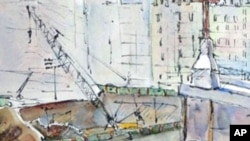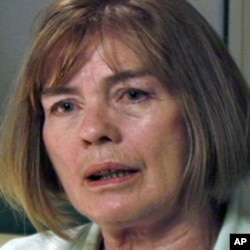Following the September 11 attacks on the World Trade Center, New York courtroom artist Aggie Kenny visited the site many times to sketch and paint the men and women working to recover the remains of the dead and clear away the debris. Then, unsure what to do with it, she put the work away - where it remained until Julie Bose, director of the New York Police Museum, happened to hear of it. Kenny's art is now the subject of a solo show at the museum, "Artist as Witness: The 9-11 Responders."
Some of New York's best-known political figures attended the opening, where Kenny's delicate sketches and watercolors of the workers at what is known as Ground Zero in the months after the attacks are on display alongside a few artifacts from the cleanup: a rake, a yellow suit.
"I actually lived just a block from the location," said Raymond Kelly, New York's police commissioner. "I think the artist has done a remarkable job of capturing the feeling of those terrible days after 9/11."
Kenny is reserved about her work. She calls herself a "reportorial" artist and says she was drawn as a witness to the former World Trade Center site.
"I think it was my way of trying to come to terms with this horrible tragedy," she said. "Like everyone else, I was just totally distraught and had no idea how things would be right again."
She needed to see it being made right, and to draw what she saw. Armed with a credential from the Salvation Army charity organization, identifying her as a "historical artist," Kenny visited Ground Zero every few days from early March to late May 2002. Images of unlikely gentleness are the result. She returned often to a huge tent that the responders called the "Taj Mahal," where they went to rest and have a meal.
"It struck me as being almost cathedral-like," Kenny said. "There were just hundreds of people bustling about, but they were basically very quiet. It was so unusual to see so many people from so many walks of life, so many backgrounds, working just beautifully together. There was a pervasive atmosphere of love, I would say."
In many of the watercolors, responders, who included police, firefighters, ironworkers, carpenters and others, appear to be physically and emotionally exhausted. One painting shows the sleep tent, where workers went to have a rest.
"Often there were men in each and every cot, with teddy bears beside them, with their boots by the cot, just totally, totally exhausted," Kenny said. "I think they fell asleep seconds after they hit the cot."
A painting from late March shows firefighters waiting for stretchers bearing the remains of two firemen who died in the attacks. Another shows a weary policeman and workers behind him with rakes.
"And of course the rakers are looking for human remains," said Kenny, "and late in the game, too, because this was the fifth of May, 2002."
When the cleanup ended that month, Kenny put the paintings and sketches away. They remained unseen until a friend told Julie Bose of their existence.
"I didn't forget about them," Kenny said. "The whole subject of 9/11 to me is sacrosanct. You don't want to take these sketches and go out to a street corner and sell them. I really didn't know for eight and a half years what I would do with these boxes of sketchbooks."
At the show's opening, police and other responders said they are glad the work is on public view. As for Kenny, she has returned to her job as a courtroom artist. She says she doesn't know if she will ever again witness scenes like those she saw at Ground Zero.












